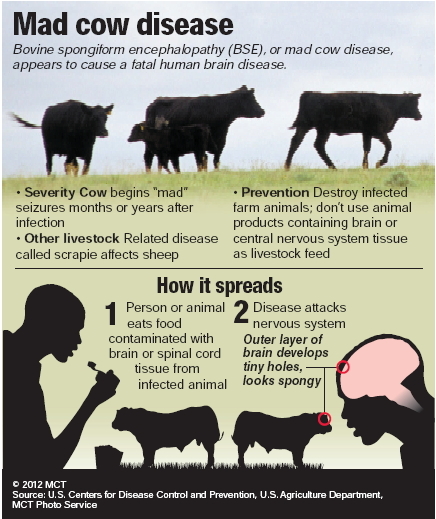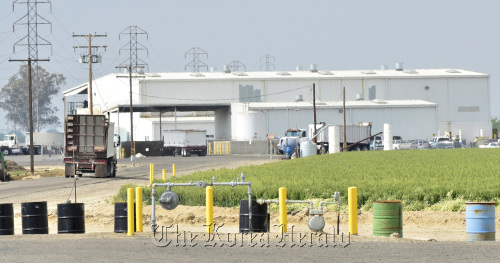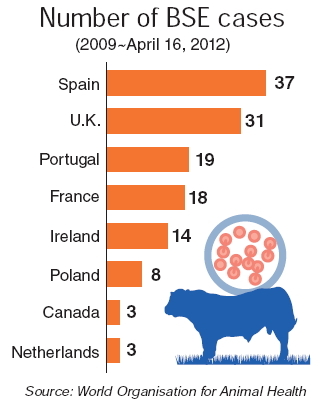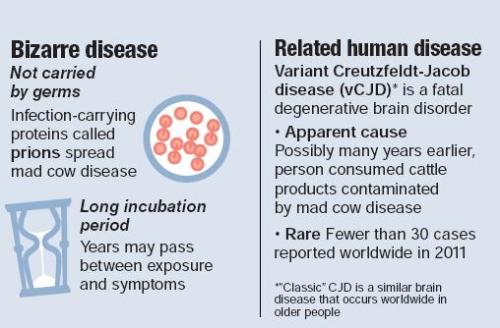Views conflict over dangers of BSE; government ignores pressure to stop customs clearanceMad
The safety of U.S. beef imports into Korea faces new questions after U.S. authorities confirmed a case of mad cow disease in a dairy cow from a California farm on April 24.
The latest discovery was the first in six years and the country’s fourth case ever.
For Korea, bovine spongiform encephalopathy (BSE), more commonly known as mad cow disease, is a high-profile issue affected by political considerations as well as scientific evidence. On May 2, 2008, about two months after Lee Myung-bak was inaugurated president on Feb. 25, anti-government demonstrations kicked off, calling for a ban on U.S. beef imports for fear of mad cow disease. The “mad cow disease” protests were among the biggest political crises President Lee faced in office. Now, with less than a year before the end of its five-year term and the presidential election slated for Dec. 19, the Lee government is faced with the same issue again.
However, the latest case of mad cow disease is of a different type than in 2008, and the public response looks much more subdued than four years ago.
To begin with, the case detected this time was “atypical,” a rare, little-researched form of mad cow disease.

The safety of U.S. beef imports into Korea faces new questions after U.S. authorities confirmed a case of mad cow disease in a dairy cow from a California farm on April 24.
The latest discovery was the first in six years and the country’s fourth case ever.
For Korea, bovine spongiform encephalopathy (BSE), more commonly known as mad cow disease, is a high-profile issue affected by political considerations as well as scientific evidence. On May 2, 2008, about two months after Lee Myung-bak was inaugurated president on Feb. 25, anti-government demonstrations kicked off, calling for a ban on U.S. beef imports for fear of mad cow disease. The “mad cow disease” protests were among the biggest political crises President Lee faced in office. Now, with less than a year before the end of its five-year term and the presidential election slated for Dec. 19, the Lee government is faced with the same issue again.
However, the latest case of mad cow disease is of a different type than in 2008, and the public response looks much more subdued than four years ago.
To begin with, the case detected this time was “atypical,” a rare, little-researched form of mad cow disease.


Little researched, conflicting views
The atypical form is known to strike different parts of the cow than the more common type. Unlike the typical form that spreads mainly through contaminated feed, atypical BSE is thought to be caused by aging. The latest case was an almost 11-year-old dairy cow, according to the U.S. Department of Agriculture. Since 2001, 65 cases of atypical mad cow disease have been reported in 15 countries, and all but one case was found in older cattle. Their average age was 12 years old, the younger exception being a 23-month-old animal in Japan.
Government officials say that Korea is not exposed to a public health risk from the rare form of BSE because the country imports U.S. beef only from cattle younger than 30 months.
“Cattle stricken with atypical mad cow disease were older,” Yoo Han-sang, a professor of the College of Veterinary Medicine of Seoul National University, said. “Studies so far show little risk of infection to humans, though there is room for dispute.”
“Self-styled experts make unverified remarks about atypical mad cow disease,” Quarantine and Inspection Agency Commissioner Park Yong-ho told reporters at a government building in Gwacheon, Gyeonggi Province on April 30. “There is no established theory about the atypical form of BSE. The general notion is that its risk is very dubious.”
Some in the U.S. media say that the latest case of mad cow disease is not nearly as threatening as the infections of the past, such as those that decimated British cattle herds in the 1980s and ‘90s and infected more than 200 people with a deadly brain disease. U.S. experts consider the risk to humans from the rare atypical form extremely low. No human case has ever been detected. And in cattle, the variant has never been seen in the U.S. until now, and is not easily transmitted.
“There is no evidence that this atypical form has ever been transmitted to humans,” Mercury News quoted Pierluigi Gambetti, a professor and pathologist specializing in mad cow disease research at Case Western Reserve University in Cleveland, as saying.
Local politicians and civic groups here, however, argue that it is problematic for the government to tell the public not to worry, despite the lack of research.
“It is a problem for the Korean government to lack critical perspective and make a judgment only with U.S. data. Beef importers should use their own logic,” said Park Sang-pyo, a member of a civic group of veterinarians who oppose the current government’s policy on U.S. beef imports.
“The government should not take steps based only on scientific facts uncovered so far because mad cow disease is still an uncertain field.”
“Atypical BSE has two types, L and H, both of which are infectious. The L type in particular is so infectious that it is likely to become a disease that infects both humans and animals,” Woo Hee-jong, a Seoul National University veterinary medicine professor, said through a social networking service. In 2007, he expressed concern about U.S. beef imports, and has questioned the related policies of the current government.
U.S. beef safety disputed
Atypical or not, is U.S. beef safe? On this matter, too, views are divided.
For mad cow disease, the U.S. randomly tests about 40,000 cows a year, less than 0.1 percent of the U.S. cattle herd.
The tests focus on older cattle and animals exhibiting symptoms of the brain-wasting disease.

According to the United Nations’ Food & Agriculture Organization and the World Organisation for Animal Health, the recent case of mad cow disease shows the U.S. surveillance system is working. The case should not affect the U.S. status of “controlled risk” for BSE, said the Paris-based animal health group, known by its French acronym OIE.
The U.S. Department of Agriculture has conducted surveillance for BSE since 1990. Surveillance has always targeted those cattle populations where the disease is most likely to be found.
The USDA’s surveillance program uses the OIE’s weighted surveillance points system, which was adopted in May 2005.
Under the OIE guidelines, points compiled over seven consecutive years are used as evidence of adequate surveillance. At the current ongoing level of surveillance, the U.S. far exceeds OIE guidelines under the point system.
But there are critics of the system in the U.S. Michael Hansen, a senior scientist at the Consumers Union, was quoted by AP as saying: “We are testing 0.12 percent of the cattle slaughtered. In Japan they test all cattle over 20 months, in Europe it’s all cattle over 24 or 30 months, depending on the country. They’ve been able to find sick animals that look healthy, but could have ended up in the food supply.”
Consumers Union issued a statement on April 24, following the announcement of the case of atypical mad cow disease in California. It raised three issues with the safety of U.S. beef.
First, the USDA testing program for mad cow disease is far too small. The USDA only tests some 40,000 cows a year of the millions slaughtered annually.
Second, detection of BSE is needlessly hindered by the fact that the USDA prohibits private companies from testing their own beef.
Third, the ruminant-to-ruminant feed ban in the U.S. to prevent the spread of mad cow disease is inadequate. The remains of cows can be fed to pigs and chickens, and pig and chicken remains can be fed back to cows.
Inadequate control in Korea
Aside from debates over the U.S. testing system for mad cow disease, how well the Korean government has controlled the risk of a BSE outbreak is another controversial point.
The Korean government banned meat and bone meal from being fed to ruminants such as cows and sheep in 2000 as the feed was cited as the main culprit behind mad cow disease.
But it is questionable how well the authorities have enforced the ban.
According to the Korea Feed Ingredients Association, Korea imported 129 tons of meat and bone meal in 2008, 110 tons in 2009 and 55 tons in 2010, all from the U.S.
Korea imported 32,124 tons of meat and bone meal from the U.S. before the third case of mad cow disease was reported in the U.S. in December 2003.
According to a report by College of Veterinary Medicine, Seoul National University, which was submitted to the government in 2009, Korea imported 20 tons of meat and bone meal from France in 2002 and 21 tons from Belgium in 2003.
According to the association, U.S. meat and bone meal imports were used in chicken feed, but the report raises the possibility of chicken feed being mingled or “cross-contaminated” with cow feed in feed mixture plants, where production lines are not separated.
Meat and bone meal is prepared from the waste materials associated with slaughtering operations and also from the rendering of dead animals.
Meat and bone meal is thought to have been responsible for the spread of BSE. Cows and other livestock were commonly fed a ground-up mash of other cows’ remains, because it was rich in protein and heighten the animals’ amino acid intake. This practice has since been abandoned in most of the developed world. The U.S. FDA banned it in 1997.
Debate on specified risk material
Local scholars also differ over the risk of mad cow disease. Pak Son-il, a veterinary medicine professor of Kangwon National University, said on a recent radio talk show that beef is safe if specified risk material is removed, which Woo of Seoul National University countered. SRM is a term for tissue of ruminant animals that cannot be inspected and passed for human food because scientists have determined that BSE-causing prions concentrate there.
Woo warned of the health risks of U.S. beef in 2008, when anti-government candlelight rallies were held over fears of mad cow disease from U.S. beef imports.
“Beef has no problem with safety, typical or atypical, if SRM is removed,” Pak said. “As studies progress, the scope of SRM varies from country to country, but no new facts have been scientifically proven regarding BSE safeguard measures, bans on meat and bone meal and SRM removal.”
“As mad cow disease progresses into other parts from SRM, pathogenic prions are reported to have been found,” Woo said. “It is dangerous to say that it would be safe to eat beef whose SRM is removed.”
Woo said that it is internationally accepted that even a small amount of SRM, unidentifiable with the naked eye, could infect humans.
He added that it would be nonsense to use the naked eye to detect BSE in efforts to strengthen quarantine inspection.
Officials under pressure
While perceptions of mad cow disease and corresponding responses are conflicting in both Korea and the U.S., the Korean government has taken the position of continuing imports of U.S. beef, raising the quarantine inspection from 3 percent to 50 percent and taking extra measures if an inspection delegation of officials and experts report significant problems after wrapping up an on-site review.
Here in Korea, mad cow disease goes out of the boundary of academic arguments and counterarguments. It easily takes shape as a politically sensitive issue touching on worry over public health and distrust with government measures. Politicians of rival parties and most civic groups are critical of the government position on the latest case of mad cow disease, no matter how hard it tries to sell the safety of U.S. beef. They demand the government stop quarantine inspections, which would mean halting domestic sales of U.S. beef, or ban imports altogether.
It was in 2008 that Korea resumed U.S. beef imports after a five-year ban. The decision to resume imports of U.S. beef without restrictions on cattle age sparked months of anti-government rallies, rocking the then-fledgling government of President Lee. They were also fanned by public speculation that his government endangered public health to curry favor with the U.S.
At that time, the government stressed that the decision was based on scientific grounds.
President Lee apologized and the government launched a re-negotiation. As a result, Korea imports only U.S. beef from animals younger than 30 months after removing all specified risk materials. Those materials are the parts considered capable of transmitting the variant Creutzfeldt-Jakob disease to humans.

Lawmakers from both ruling and opposition parties, who sit on the related committee, adopted a resolution on May 1 to urge the government to suspend customs clearance of U.S. beef until its safety is guaranteed.
It is likely an embarrassment to the government, which did not expect a resolution from the related parliamentary panel to open a session on the recent case of mad cow disease in the U.S. Lawmakers of rival parties criticized Minister for Food, Agriculture, Forestry and Fisheries Suh Kyu-yong over his remarks that U.S. beef imported to Korea is safe. Suh says the latest case involving a dairy cow is not directly connected to beef that can be shipped to the country.
Civic groups began a candlelit vigil near Cheonggye Plaza in central Seoul on the following day to commemorate the first protest that took place on the same day four years ago.
However, the scale and intensity of the vigil attended by about 1,500 as estimated by police, was far below the months-long protests in 2008 in which an estimated 1.5 million took to the streets, calling for the impeachment of Lee.
On-the-spot inspection ineffective
The government has dispatched a team to the U.S. to conduct an “on-the-scene” review. While the government has repeated that it would consider extra measures based on its report after returning home, local media are skeptical of the effectiveness of its on-the-scene inspection. To begin with, the nine-member delegation includes no figure critical of U.S. beef imports.
Among other things, the inspection team left for the U.S. not knowing the location of the farm where the infected cow lived. In the end, they failed to visit the dairy farm. Inspectors reportedly asked a U.S. veterinarian to pose questions to the owner of the farm with the answers given related to the team.
New facts did not come from the delegation, but from U.S. media covering the USDA.
On Thursday, CNN reported two farms have been quarantined by the U.S. Department of Agriculture as the agency continues to investigate last month’s discovery of mad cow disease at a California dairy farm.
Authorities have launched an investigation at a calf ranch where the initial infected cow was raised 10 years ago, according to a statement released by the USDA.
The farm where the cow was initially discovered has been under quarantine since the discovery, and a second quarantine involves a farm closely associated with the diary where the sick cow was discovered. The agency is still trying to determine if any at-risk cattle are present at either of the two farms.
“The government delegation will see only what the U.S. will show. I wonder why the government sent the team, while claiming that U.S. beef is safe enough not to ban imports or suspend quarantine inspection,” Woo wrote on Twitter.
By Chun Sung-woo (swchun@heraldcorp.com)
-
Articles by Korea Herald








![[KH Explains] Hyundai's full hybrid edge to pay off amid slow transition to pure EVs](http://res.heraldm.com/phpwas/restmb_idxmake.php?idx=644&simg=/content/image/2024/04/18/20240418050645_0.jpg&u=20240419100350)







![[From the Scene] Monks, Buddhists hail return of remains of Buddhas](http://res.heraldm.com/phpwas/restmb_idxmake.php?idx=652&simg=/content/image/2024/04/19/20240419050617_0.jpg&u=20240419175937)

![[KH Explains] Hyundai's full hybrid edge to pay off amid slow transition to pure EVs](http://res.heraldm.com/phpwas/restmb_idxmake.php?idx=652&simg=/content/image/2024/04/18/20240418050645_0.jpg&u=20240419100350)

![[Today’s K-pop] Illit drops debut single remix](http://res.heraldm.com/phpwas/restmb_idxmake.php?idx=642&simg=/content/image/2024/04/19/20240419050612_0.jpg&u=)